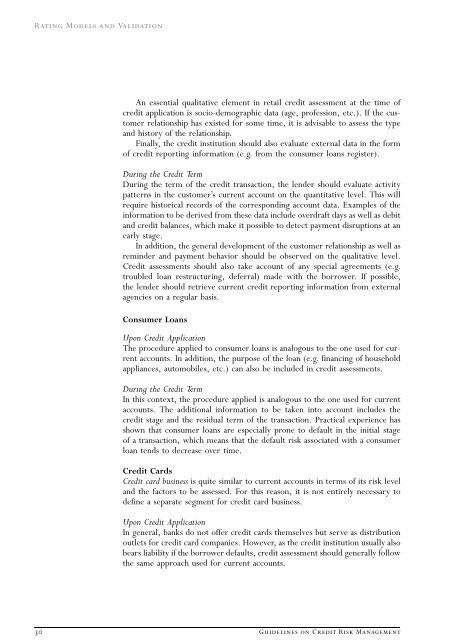Rating Models and Validation - Oesterreichische Nationalbank
Rating Models and Validation - Oesterreichische Nationalbank
Rating Models and Validation - Oesterreichische Nationalbank
You also want an ePaper? Increase the reach of your titles
YUMPU automatically turns print PDFs into web optimized ePapers that Google loves.
<strong>Rating</strong> <strong>Models</strong> <strong>and</strong> <strong>Validation</strong><br />
An essential qualitative element in retail credit assessment at the time of<br />
credit application is socio-demographic data (age, profession, etc.). If the customer<br />
relationship has existed for some time, it is advisable to assess the type<br />
<strong>and</strong> history of the relationship.<br />
Finally, the credit institution should also evaluate external data in the form<br />
of credit reporting information (e.g. from the consumer loans register).<br />
During the Credit Term<br />
During the term of the credit transaction, the lender should evaluate activity<br />
patterns in the customerÕs current account on the quantitative level. This will<br />
require historical records of the corresponding account data. Examples of the<br />
information to be derived from these data include overdraft days as well as debit<br />
<strong>and</strong> credit balances, which make it possible to detect payment disruptions at an<br />
early stage.<br />
In addition, the general development of the customer relationship as well as<br />
reminder <strong>and</strong> payment behavior should be observed on the qualitative level.<br />
Credit assessments should also take account of any special agreements (e.g.<br />
troubled loan restructuring, deferral) made with the borrower. If possible,<br />
the lender should retrieve current credit reporting information from external<br />
agencies on a regular basis.<br />
Consumer Loans<br />
Upon Credit Application<br />
The procedure applied to consumer loans is analogous to the one used for current<br />
accounts. In addition, the purpose of the loan (e.g. financing of household<br />
appliances, automobiles, etc.) can also be included in credit assessments.<br />
During the Credit Term<br />
In this context, the procedure applied is analogous to the one used for current<br />
accounts. The additional information to be taken into account includes the<br />
credit stage <strong>and</strong> the residual term of the transaction. Practical experience has<br />
shown that consumer loans are especially prone to default in the initial stage<br />
of a transaction, which means that the default risk associated with a consumer<br />
loan tends to decrease over time.<br />
Credit Cards<br />
Credit card business is quite similar to current accounts in terms of its risk level<br />
<strong>and</strong> the factors to be assessed. For this reason, it is not entirely necessary to<br />
define a separate segment for credit card business.<br />
Upon Credit Application<br />
In general, banks do not offer credit cards themselves but serve as distribution<br />
outlets for credit card companies. However, as the credit institution usually also<br />
bears liability if the borrower defaults, credit assessment should generally follow<br />
the same approach used for current accounts.<br />
30 Guidelines on Credit Risk Management

















